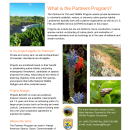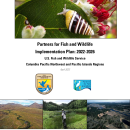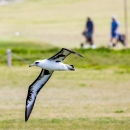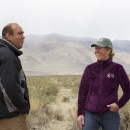Partners for Fish and Wildlife Program Pacific Islands
The Partners for Fish and Wildlife Program assists private landowners to voluntarily establish, restore, or enhance native species habitat. Landowners typically work with a partner organization as well as a U.S. Fish and Wildlife Service (USFWS) biologist on the project.
Projects can include but are not limited to, fence construction, invasive species invasive species
An invasive species is any plant or animal that has spread or been introduced into a new area where they are, or could, cause harm to the environment, economy, or human, animal, or plant health. Their unwelcome presence can destroy ecosystems and cost millions of dollars.
Learn more about invasive species control, out-planting of native plants, and restoration of ecosystem elements such as hydrology as in the case of wetlands and stream corridors.
Is my project eligible for Partners?
Private and county land, as well as Department of Hawaiian Homelands are all eligible.
Projects are prioritized based on their benefit in: establishing native habitat, supporting endangered, threatened, candidates or species proposed for listing, responding to the needs of declining migratory birds and/or fish species, and projects that buffer National Wildlife Refuges and other protected areas.
Learn more about the Partners Implementation Plan.
Project Budget
Projects $25,000 or under are preferred, however waivers are available. Ideal projects are 1-3 years and focus on achieving parts of a larger project scope (such as fencing and weed control). Landowners who receive funding enter into a ten year cooperative agreement to maintain the habitat.
Where We Work
The Partners Program can work in Hawaii, American Samoa, Guam, Commonwealth of the Northern Mariana Islands, Republic of Palau, Federated States of Micronesia, and the Marshall Islands.
Past Projects
ʻElepaio — Oʻahu
In 2012, a private landowner partnered with Pacific Rim Conservation and utilized $13,000 of Partner funds to install traps around Oʻahu ʻelepaio (Chasiempis ibidis) nesting locations.
The Oʻahu ʻelepaio currently occupies less than 25% of its 1975 range and has declined in abundance by about 50% since the 1990s.
Keālia Beach — Maui
On Maui, Alexander and Baldwin worked with the Keālia National Wildlife Refuge and was awarded $50,000 from the Partners Program to install fences and barriers to prevent sea turtles from crossing the highway. This improved 4.5 acres of habitat for the endangered Hawksbill sea turtle (Eretmochelys imbricate) or ‘ea in Hawaiian.
Nuʻu Pond — Hawaiʻi
The Partners Program contributed $8,000 to Kaupō Ranch, who coordinated with the State Division of Forestry and Wildlife to restore a wetland. 2.5 acres of wetland were improved by constructing cattle fencing, invasive plant removal, and native plant establishment for the endangered Hawaiian stilt or aeʻo (Himantopus mexicanus knudseni) and Hawaiian coot or ʻalae keʻokeʻo (Fulica americana alai).






